In this article
Every hiker knows the feeling: that tiny, nagging pebble that works its way into your boot, or the slow, creeping dampness that seeps into your socks from wet grass. These common trail annoyances can lead to blisters and discomfort, turning a great day out into a painful slog. A hiking gaiter is the simple, effective solution—a protective sleeve that bridges the gap between your pants and hiking boots, creating a seal against the elements. Far from a niche accessory, these are versatile tools for any hike. This guide is your definitive resource on hiking with gaiters, covering everything from benefits and types to materials, fit, use, and maintenance.
Are Gaiters Really Necessary? The 5 Key Benefits
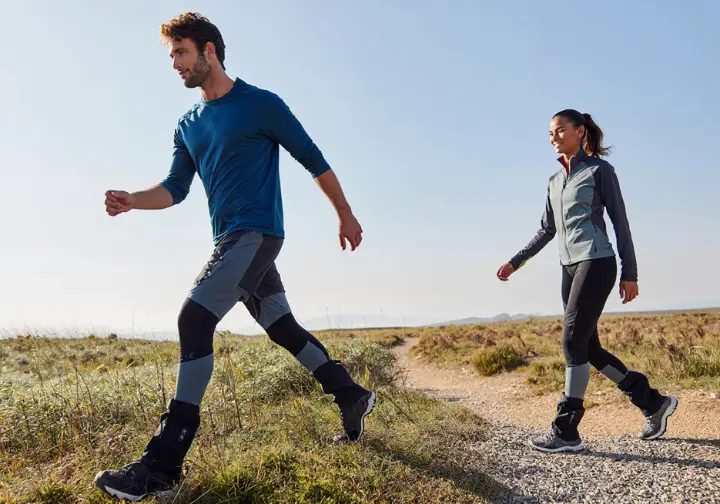
Many hikers debate the necessity of gaiters, often viewing them as an extra piece of gear to carry. For certain conditions and terrains, however, their value is undeniable. They transition from a perceived luxury to an essential tool that provides a disproportionate amount of comfort and protection for their weight, directly addressing some of hiking’s most persistent problems for backpackers and day hikers alike.
Benefit 1: Debris Defense – The End of Trail Intruders
The most fundamental purpose of a gaiter is to form a physical barrier over the top of your footwear. This simple function prevents intrusion from scree, sand, dirt, and forest duff that would otherwise find its way into your hiking shoes. This is more than a minor annoyance; a single pebble creates constant friction, leading to hot spots and painful blisters that can ruin a trek. By eliminating the need to constantly stop and empty your boots, you can maintain a more continuous and comfortable hiking rhythm. This benefit is a cornerstone of good foot care, directly contributing to foot health on any long trail.
Benefit 2: Moisture Management – Staying Drier for Longer
Gaiters are a key part of a hiker’s moisture management system, helping to shed water from wet brush and preventing mud or snow from overtopping your boots on wet spring trails. They are especially vital when wearing rain pants, as they block water from running down your leg and funneling directly into the ankle opening of your footwear. To be clear, these gaiters don’t make your boots completely waterproof, but they plug the main point of water ingress. By preventing morning dew from saturating the tops of socks, they help prevent skin maceration—a major cause of blisters—and speed up gear drying time at camp.
Benefit 3: Protection for Your Legs & Gear
Mid and full-length gaiters provide significant protection for your lower legs, shielding your shins from painful scratches during off-trail hikes. An often-overlooked benefit is the protection they offer your gear. Gaiters act as a sacrificial layer, absorbing damage that would otherwise tear expensive equipment. They provide critical protection against errant crampon points or microspikes that could easily shred expensive hiking pants or puncture waterproof membranes on mountaineering boots. This makes them a wise investment, as replacing an expensive gaiter is far more economical than replacing high-end technical apparel.
Benefit 4: A Shield Against Pests and Snakes
In many regions, pests pose a real risk on the trail. Knee-high gaiters create a physical barrier that helps prevent ticks from crawling up a pant leg to access the skin, thereby reducing the risk of tick-borne illnesses in areas like the Southern Appalachians. For hikers in areas with venomous reptiles, specialized equipment offers critical peace of mind. While standard gaiters offer some defense, specialized snake gaiters are available for a higher level of safety. These are constructed from tough, puncture-resistant materials designed specifically to withstand a snake bite.
The 3 Main Types of Gaiters: Matching Height to Your Hike
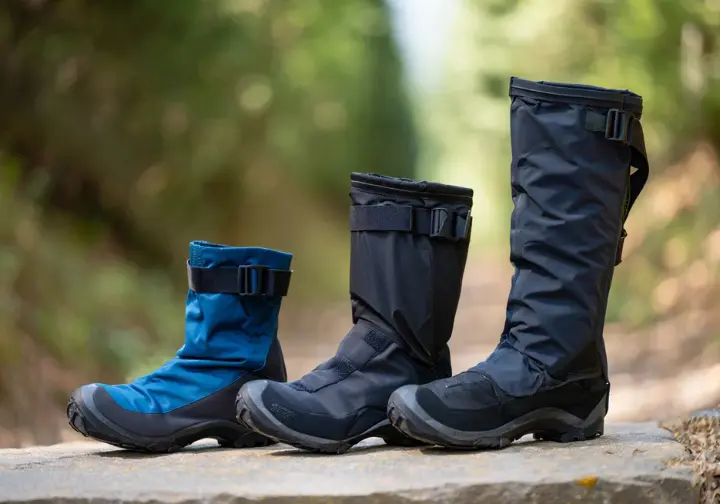
The most fundamental way to classify gaiters is by their height. This single characteristic most directly corresponds to their intended use and is the first major decision you’ll make when selecting a pair. Understanding the three main gaiter heights will help you match your gear to your hike perfectly.
Low (Ankle) Gaiters: For Trail Runners and Light Hikers
Low gaiters, often called short gaiters for hiking, are the lightest option, typically made from breathable, stretchy fabrics. As dedicated ankle gaiters for hiking, they cover just the top of a low-cut hiking shoe or trail runner and extend slightly above the ankle bone. Their primary purpose is to keep small debris out of your footwear during 3-season hiking and trail running on well-maintained trails. They are ultralight and comfortable but offer minimal water resistance. Well-known examples for ultralight hikers include Dirty Girl Gaiters and Altra Trail Gaiters.
Mid-Calf Gaiters: The Versatile All-Rounder
Mid-calf gaiters are the versatile workhorses of the category, measuring 8-12 inches high and reaching the middle of the calf. Positioned as the ideal choice for general 3-season backpacking and hiking, these mid-length gaiters offer an excellent balance of protection, weight, and breathability. They provide more defense from mud and water than low gaiters without the heat of full-height models, making them some of the best backpacking gaiters. While they offer insufficient coverage for deep snow, their balanced design, seen in models like the Kahtoola RENAgaiter, makes them a go-to for many backpackers.
Full (Knee-Height) Gaiters: For Maximum Protection
Full-height gaiters are the most protective and heavy-duty option, extending from the boot to just below the knee. Their use is reserved for the most rugged conditions, including mountaineering, snowshoeing, ice climbing, deep snow, and heavy rain. These winter gaiters are typically fully waterproof and durable. While they can be overkill for standard trail use, their maximum protection is non-negotiable in harsh wilderness environments like the Glacier Peak Wilderness. The Outdoor Research Crocodile gaiter is a long-standing benchmark in this full-length gaiter category.
How to Choose: A 3-Step Guide to Finding the Perfect Gaiter

Selecting the right gaiter involves more than just picking a height. A clear, step-by-step approach will guide you through the critical decisions of matching materials to your environment, achieving a perfect fit, and matching the features to your specific adventure type. Gaiter shopping becomes much easier with this framework.
Step 1: Match Materials to Your Mission
The choice of gaiter material is a fundamental trade-off between waterproofness and durability versus breathability. Your intended environment dictates the correct balance. For wet conditions, look for waterproof/breathable laminates like a GORE-TEX gaiter option. For extreme durability, high-denier coated nylons like Cordura® are excellent, as a higher number for the fabric’s denier (D) signifies more robust nylon gaiters. For hot conditions, prioritize highly breathable materials like stretchy elastane gaiters or more durable stretch-woven nylons.
Step 2: Ensure a Perfect Fit for Your Legs & Footwear
A proper fit is non-negotiable, as any gaps defeat the purpose of the gear. Sizing goes beyond just shoe size; measure your calf circumference to find the right size gaiters. You must also account for the bulk of your footwear. When considering footwear bulk, remember that stout mountaineering boots require a larger gaiter circumference than streamlined hiking shoes. Finally, pay attention to the gaiter strap. Traditional instep straps work best with hiking boots that have a recessed arch. In contrast, flat-soled trail runners will rapidly destroy these straps; they require a different attachment system.
Step 3: Match Gaiters to Your Adventure
This step synthesizes your choices for specific hiking styles. A day hiker on short day hikes will do well with a low or mid-height breathable model like the REI Co-op Flash Gaiter. A multi-day backpacker on the John Muir Trail should look for a versatile, durable mid-height model. For the ultralight thru-hiker on trails like the PCT, ultralight spandex Dirty Girl Gaiters are a common choice, often used only for notoriously sandy or debris-filled sections. For winter hikers and mountaineers, a full-height, waterproof model like the OR Crocodile is the appropriate gaiter for protection.
How to Put on Hiking Gaiters Correctly
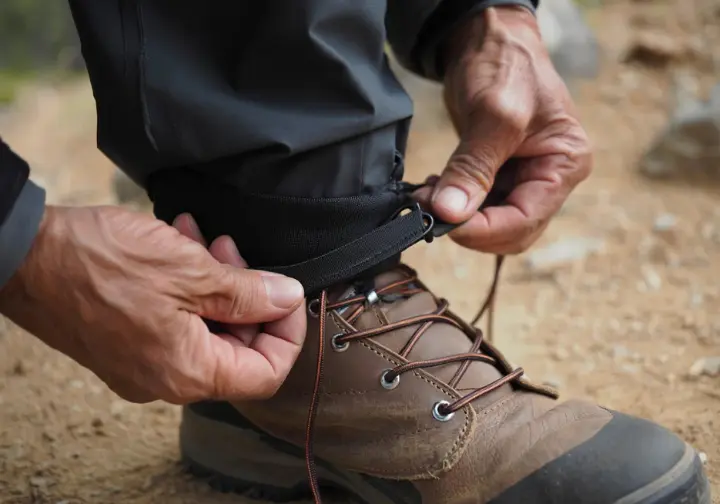
Learning how to properly wear gaiters is a simple skill that ensures these boot gaiters for hiking perform as intended, creating a secure seal to keep you comfortable on the trail. Following the correct sequence is the key to a perfect fit.
- Step 1: Identify Left & Right: Most gaiters are anatomically shaped. The buckles for the instep strap… should be positioned on the outside of your feet. This prevents you from accidentally kicking them open while walking.
- Step 2: Secure the Lace Hook: With your boots and pants on, attach the small hook at the front bottom of the hiking gaiter to your boot’s laces. Anchor it as far down toward the toe as is comfortable to keep the front of the gaiter from riding up.
- Step 3: Fasten & Adjust: Fasten the front closure—usually Velcro or a zipper—from the bottom up for a clean seal. Pass the instep strap under your boot and secure it in the recessed arch. Cinch the top closure so it’s snug enough to stay up without restricting circulation; you should be able to fit one or two fingers underneath.
Keeping Your Gaiters Trail-Ready: Cleaning and Maintenance
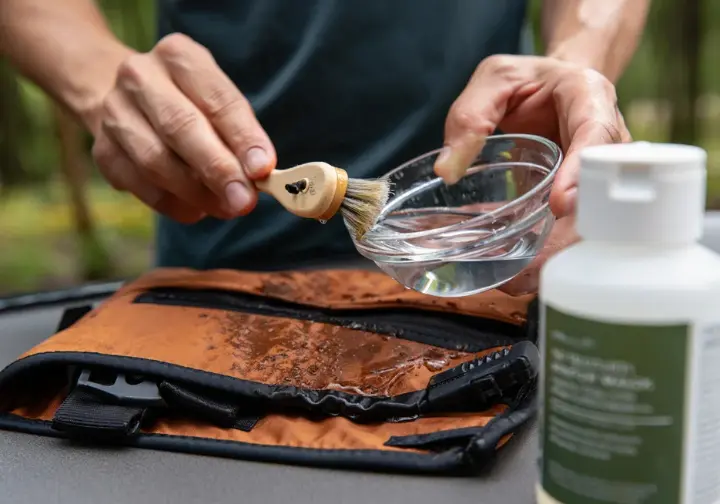
Proper care will extend the lifespan of your gaiters and preserve their performance. A little maintenance goes a long way, especially for waterproof gaiters that rely on technical fabrics to keep you dry.
Washing and Restoring Water Repellency (DWR)
It’s a myth that washing technical fabrics like GORE-TEX is harmful. In fact, dirt and body oils clog the membrane’s pores, inhibiting breathability. To clean them, secure all gaiter closures and Machine wash on a warm, gentle cycle using a tech wash. Run a second rinse cycle and avoid powders or softeners. For restoring water repellency, first try reactivating the existing DWR finish with 20 minutes in a warm dryer. If water no longer beads up, reapply a DWR product and cure it with heat according to the product’s instructions.
Trailside Triage: Field Repairs
Preparing for common gear failures in the backcountry is a mark of an experienced hiker. The instep strap is the most common failure point. Always carry a length of accessory cord, which can be threaded through the attachment points as a replacement. For fabric tears from rocks or crampons, carry adhesive gear tape, such as Tenacious Tape. Clean and dry the area, cut a patch with rounded corners, and apply it smoothly. For a failed zipper or clogged Velcro, a stiff brush can clean out debris, and duct tape can provide a temporary closure.
The Final Word: An Essential Part of Your Hiking System
Gaiters are a strategic tool that provides an outsized benefit for their cost and weight in the right conditions. The core principle of selection is simple: balance protection, durability, and breathability based on your specific trip and environment. By understanding gaiter anatomy, materials, and fit, you can choose the perfect gear for your needs. This knowledge empowers you to make informed choices, treating your gear as an integrated part of your hiking system for safer, more comfortable, and more enjoyable experiences on all your hikes.
Frequently Asked Questions about Hiking with Gaiters
How tight should my gaiters be? +
Can I wear gaiters with shorts? +
What is the difference between men’s and women’s gaiters? +
Do I need to treat my gaiters with permethrin for ticks? +
We are a participant in the Amazon Services LLC Associates Program, an affiliate advertising program designed to provide a means for sites to earn advertising fees by advertising and linking to Amazon.com. As an Amazon Associate I earn from qualifying purchases. We also participate in other affiliate programs. The information provided on this website is provided for entertainment purposes only. We make no representations or warranties of any kind, expressed or implied, about the completeness, accuracy, adequacy, legality, usefulness, reliability, suitability, or availability of the information, or about anything else. Any reliance you place on the information is therefore strictly at your own risk. Additional terms are found in the terms of service.



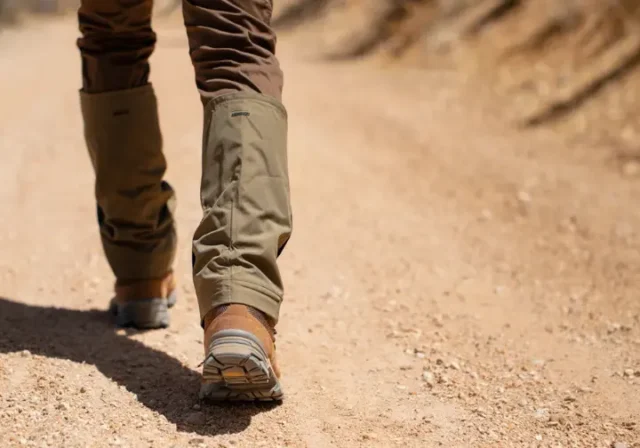
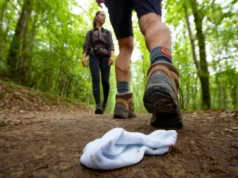




![Trek Budgeting: A Data-Backed Guide [+ Free Template] A trekker sits at a desk planning a trip budget on a laptop, with a stunning view of the Himalayan mountains visible through a window behind them.](https://thehikingtribe.com/wp-content/uploads/2025/07/00-trek-budgeting-data-backed-planning-100x75.webp)

